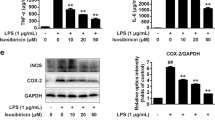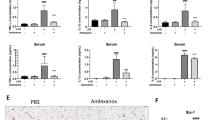Abstract
The present study aimed to investigate the potential role of microRNA-141-3p (miR-141-3p) in chronic inflammatory pain (CIP) by targeting the high-mobility group box1 (HMGB1) gene. In the in vitro study, BV2 microglial cells were selected and assigned into blank, lipopolysaccharide (LPS), miR-141-3p mimics, mimics control, miR-141-3p inhibitor, inhibitor control, miR-141-3p mimics+LPS, mimics control+ LPS, miR-141-3p inhibitor+LPS and inhibitor control+LPS groups. Ninety-six rats were randomly divided into 8 groups (12 rats in each group): blank control, model control, negative control (NC), miR-141-3p mimics+ complete Freund’s adjuvant (CFA), mimics control+CFA, HMGB1 short hairpin RNA (shRNA)+CFA, HMGB1 NC+CFA and miR-141-3p mimics+HMGB1 shRNA+CFA groups. The quantitative real-time PCR, western blotting, enzyme-linked immunosorbent assay and pain behavioral test were used to measure the miR-141-3p and HMGB1 mRNA expressions, HMGB1 protein expression, inflammatory cytokines levels, and thermal and mechanical pain thresholds, respectively. Compared with the blank, mimics control, inhibitor control and miR-141-3p mimics+LPS groups, the miR-141-3p mimics group had increased miR-141-3p expression and interleukin (IL)-10 levels, and had decreased mRNA and protein expressions of HMGB1 and the levels of IL-1β, tumor necrosis factor-α (TNF-α) and IL-6, whereas the opposite trend were found in the LPS, miR-141-3p inhibitor, mimics control+LPS and inhibitor control+LPS groups. Compared with the LPS, miR-141-3p inhibitor, mimics control+LPS and inhibitor control+LPS groups, the miR141-3p+LPS group had an obviously decreased expression of miR-141-3p and IL-10, increased mRNA and protein expressions of HMGB1 and the levels of IL-1β, TNF-α and IL-6. Compared with the rats in the blank control group, the miR-141-3p expression, IL-10 level, and thermal and mechanical pain thresholds decreased significantly, whereas the mRNA and protein expressions of HMGB1, IL-1β, TNF-α and IL-6 increased significantly in rats in the NC, mimics control+CFA and HMGB1 NC+ CFA groups. The miR-141-3p expression was increased in rats in the miR-141-3p mimics+HMGB1 shRNA+CFA group. Our study demonstrated that miR-141-3p can alleviate the CIP by downregulating the downstream target gene HMGB1.
This is a preview of subscription content, access via your institution
Access options
Subscribe to this journal
Receive 12 print issues and online access
$259.00 per year
only $21.58 per issue
Buy this article
- Purchase on Springer Link
- Instant access to full article PDF
Prices may be subject to local taxes which are calculated during checkout









Similar content being viewed by others
References
Montrucchio DP, Cordova MM, Santos AR . Plant derived aporphinic alkaloid S-(+)-dicentrine induces antinociceptive effect in both acute and chronic inflammatory pain models: evidence for a role of TRPA1 channels. PLoS ONE 2013; 8: e67730.
Berger ND, Gadotti VM, Petrov RR, Chapman K, Diaz P, Zamponi GW . NMP-7 inhibits chronic inflammatory and neuropathic pain via block of Cav3.2T-type calcium channels and activation of CB2 receptors. Mol Pain 2014; 10: 77.
Descalzi G, Ikegami D, Ushijima T, Nestler EJ, Zachariou V, Narita M . Epigenetic mechanisms of chronic pain. Trends Neurosci 2015; 38: 237–246.
Lee YC . Effect and treatment of chronic pain in inflammatory arthritis. Curr Rheumatol Rep 2013; 15: 300.
Lisi L, Aceto P, Navarra P, Dello Russo C . mTOR kinase: a possible pharmacological target in the management of chronic pain. Biomed Res Int 2015; 2015: 394257.
Wang C, Liu C, Wan H, Wang D, Sun D, Xu T et al. Wu-tou decoction inhibits chronic inflammatory pain in mice: participation of TRPV1 and TRPA1 ion channels. Biomed Res Int 2015; 2015: 328707.
Bai G, Ambalavanar R, Wei D, Dessem D . Downregulation of selective microRNAs in trigeminal ganglion neurons following inflammatory muscle pain. Mol Pain 2007; 3: 15.
Andersen HH, Duroux M, Gazerani P . MicroRNAs as modulators and biomarkers of inflammatory and neuropathic pain conditions. Neurobiol Dis 2014; 71: 159–168.
Sakai A, Suzuki H . Emerging roles of microRNAs in chronic pain. Neurochem Int 2014; 77: 58–67.
Kusuda R, Cadetti F, Ravanelli MI, Sousa TA, Zanon S, De Lucca FL et al. Differential expression of microRNAs in mouse pain models. Mol Pain 2011; 7: 17.
Li X, Kroin JS, Kc R, Gibson G, Chen D, Corbett GT et al. Altered spinal microRNA-146a and the microRNA-183 cluster contribute to osteoarthritic pain in knee joints. J Bone Miner Res 2013; 28: 2512–2522.
Dong Y, Li P, Ni Y, Zhao J, Liu Z . Decreased microRNA-125a-3p contributes to upregulation of p38 MAPK in rat trigeminal ganglions with orofacial inflammatory pain. PLoS ONE 2014; 9: e111594.
Zhang J, Zhang H, Zi T . Overexpression of microRNA-141 relieves chronic constriction injury-induced neuropathic pain via targeting high-mobility group box 1. Int J Mol Med 2015; 36: 1433–1439.
Allette YM, Due MR, Wilson SM, Feldman P, Ripsch MS, Khanna R et al. Identification of a functional interaction of HMGB1 with receptor for advanced glycation end-products in a model of neuropathic pain. Brain Behav Immun 2014; 42: 169–177.
Asavarut P, Zhao H, Gu J, Ma D . The role of HMGB1 in inflammation-mediated organ injury. Acta Anaesthesiol Taiwan 2013; 51: 28–33.
Wang YS, Li YY, Wang LH, Kang Y, Zhang J, Liu ZQ et al. Tanshinone IIA attenuates chronic pancreatitis-induced pain in rats via downregulation of HMGB1 and TRL4 expression in the spinal cord. Pain Physician 2015; 18: E615–E628.
Agalave NM, Svensson CI . Extracellular high-mobility group box 1 protein (HMGB1) as a mediator of persistent pain. Mol Med 2014; 20: 569–578.
Zhang ZH, Chen XH, Jiang ZX, Chen WY, Xiong XM . Role of microRNA-141 in the regulation of synthesis of high mobility group protein B1 in THP-1 cells. Zhonghua Wei Zhong Bing Ji Jiu Yi Xue 2013; 25: 604–607.
Cruz-Almeida Y, King CD, Wallet SM, Riley JL 3rd . Immune biomarker response depends on choice of experimental pain stimulus in healthy adults: a preliminary study. Pain Res Treat 2012; 2012: 538739.
Andrade P, Hoogland G, Garcia MA, Steinbusch HW, Daemen MA, Visser-Vandewalle V . Elevated IL-1beta and IL-6 levels in lumbar herniated discs in patients with sciatic pain. Eur Spine J 2013; 22: 714–720.
England A, Valdes AM, Slater-Jefferies JL, Gill R, Howell WM, Calder PC et al. Variants in the genes encoding TNF-alpha, IL-10, and GSTP1 influence the effect of alpha-tocopherol on inflammatory cell responses in healthy men. Am J Clin Nutr 2012; 95: 1461–1467.
Biesmans S, Bouwknecht JA, Ver Donck L, Langlois X, Acton PD, De Haes P et al. Peripheral administration of tumor necrosis factor-alpha induces neuroinflammation and sickness but not depressive-like behavior in mice. Biomed Res Int 2015; 2015: 716920.
Westlund KN, Zhang L, Ma F, Oz HS . Chronic inflammation and pain in a tumor necrosis factor receptor (TNFR) (p55/p75-/-) dual deficient murine model. Transl Res 2012; 160: 84–94.
Xu F, Li Y, Li S, Ma Y, Zhao N, Liu Y et al. Complete Freund’ adjuvant-induced acute inflammatory pain could be attenuated by triptolide via inhibiting spinal glia activation in rats. J Surg Res 2014; 188: 174–182.
Duan G, Xiang G, Zhang X, Guo S, Zhang Y . An improvement of mechanical pain sensitivity measurement method: the smaller sized probes may detect heterogeneous sensory threshold in healthy male subjects. Pain Med 2014; 15: 272–280.
Abramova AY, Kozlov AY, Pertsov SS . Dynamics of changes in nociceptive reactions of rats after peripheral administration of lipopolysaccharide. Bull Exp Biol Med 2014; 157: 413–415.
Ruiz-Miyazawa KW, Pinho-Ribeiro FA, Zarpelon AC, Staurengo-Ferrari L, Silva RL, Alves-Filho JC et al. Vinpocetine reduces lipopolysaccharide-induced inflammatory pain and neutrophil recruitment in mice by targeting oxidative stress, cytokines and NF-kappaB. Chem Biol Interact 2015; 237: 9–17.
Zhao XH, Zhang T, Li YQ . The up-regulation of spinal Toll-like receptor 4 in rats with inflammatory pain induced by complete Freund’s adjuvant. Brain Res Bull 2015; 111: 97–103.
Chen W, Guo S, Wang S . MicroRNA-16 alleviates inflammatory pain by targeting ras-related protein 23 (RAB23) and inhibiting p38 MAPK activation. Med Sci Monit 2016; 22: 3894–3901.
Kasinski AL, Slack FJ . Epigenetics and genetics. MicroRNAs en route to the clinic: progress in validating and targeting microRNAs for cancer therapy. Nat Rev Cancer 2011; 11: 849–864.
Livak KJ, Schmittgen TD . Analysis of relative gene expression data using real-time quantitative PCR and the 2(-Delta Delta C(T)) method. Methods 2001; 25: 402–408.
Acknowledgements
We give our sincere appreciation to the reviewers for their helpful comments on this article.
Author information
Authors and Affiliations
Corresponding author
Ethics declarations
Competing interests
The authors declare no conflict of interest.
Rights and permissions
About this article
Cite this article
Shen, WS., Xu, XQ., Zhai, NN. et al. Potential mechanisms of microRNA-141-3p to alleviate chronic inflammatory pain by downregulation of downstream target gene HMGB1: in vitro and in vivo studies. Gene Ther 24, 353–360 (2017). https://doi.org/10.1038/gt.2017.28
Received:
Revised:
Accepted:
Published:
Issue Date:
DOI: https://doi.org/10.1038/gt.2017.28
This article is cited by
-
Downregulation of lncRNA FIRRE relieved the neuropathic pain of female mice by suppressing HMGB1 expression
Molecular and Cellular Biochemistry (2021)
-
miR-449a inhibits cell proliferation, migration, and inflammation by regulating high-mobility group box protein 1 and forms a mutual inhibition loop with Yin Yang 1 in rheumatoid arthritis fibroblast-like synoviocytes
Arthritis Research & Therapy (2019)
-
Transplantation of endothelial progenitor cells attenuated paraquat-induced acute lung injury via miR-141-3p-Notch-Nrf2 axis
Cell & Bioscience (2018)
-
miR-451 elevation relieves inflammatory pain by suppressing microglial activation-evoked inflammatory response via targeting TLR4
Cell and Tissue Research (2018)



